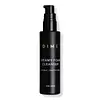What's inside
What's inside
 Key Ingredients
Key Ingredients

 Benefits
Benefits

 Concerns
Concerns

 Ingredients Side-by-side
Ingredients Side-by-side

Water
Skin ConditioningButylene Glycol
HumectantPentylene Glycol
Skin ConditioningGlycerin
HumectantSodium Cocoyl Glutamate
CleansingCoco-Betaine
CleansingCaprylyl Glycol
EmollientCetyl Hydroxyethylcellulose
Emulsion StabilisingPCA Ethyl Cocoyl Arginate
MoisturisingPyrus Malus Fruit Extract
Skin ConditioningBeta Vulgaris Root Extract
Skin ConditioningFructooligosaccharides
HumectantGlycolic Acid
BufferingCaprylhydroxamic Acid
Piroctone Olamine
PreservativeTetrasodium Glutamate Diacetate
Bakuchiol
AntimicrobialSodium PCA
HumectantAloe Barbadensis Leaf Juice
Skin ConditioningArtemisia Vulgaris Extract
Skin ConditioningDipotassium Glycyrrhizate
HumectantLaminaria Digitata Extract
Skin ProtectingZinc PCA
HumectantCinnamomum Cassia Bark Extract
MaskingSanguisorba Officinalis Root Extract
CleansingZingiber Officinale Root Extract
MaskingWater, Butylene Glycol, Pentylene Glycol, Glycerin, Sodium Cocoyl Glutamate, Coco-Betaine, Caprylyl Glycol, Cetyl Hydroxyethylcellulose, PCA Ethyl Cocoyl Arginate, Pyrus Malus Fruit Extract, Beta Vulgaris Root Extract, Fructooligosaccharides, Glycolic Acid, Caprylhydroxamic Acid, Piroctone Olamine, Tetrasodium Glutamate Diacetate, Bakuchiol, Sodium PCA, Aloe Barbadensis Leaf Juice, Artemisia Vulgaris Extract, Dipotassium Glycyrrhizate, Laminaria Digitata Extract, Zinc PCA, Cinnamomum Cassia Bark Extract, Sanguisorba Officinalis Root Extract, Zingiber Officinale Root Extract
Water
Skin ConditioningDisodium Laureth Sulfosuccinate
CleansingSodium Hydroxypropylsulfonate Laurylglucoside Crosspolymer
CleansingLauryl Glucoside
CleansingSodium Lauryl Sulfoacetate
CleansingSodium Chloride
MaskingDisteareth-75 Ipdi
Bifida Ferment Lysate
Skin ConditioningHydrolyzed Rice Protein
Skin ConditioningCurcuma Longa Root Extract
MaskingCamellia Sinensis Leaf Extract
AntimicrobialVaccinium Angustifolium Fruit Extract
Skin ProtectingCichorium Intybus Root Extract
MaskingCamelina Sativa Seed Oil
Skin ConditioningLactose
HumectantLactis Proteinum
Skin ConditioningYogurt Powder
Vegetable Oil
Skin ConditioningTocopheryl Acetate
AntioxidantAscorbyl Palmitate
AntioxidantPanthenol
Skin ConditioningCarthamus Tinctorius Seed Oil
MaskingPolysorbate 20
EmulsifyingButylene Glycol
HumectantInulin
Skin ConditioningPentylene Glycol
Skin ConditioningCaprylyl Glycol
EmollientCoco-Glucoside
CleansingHydroxyethyl Acrylate/Sodium Acryloyldimethyl Taurate Copolymer
Emulsion StabilisingEthylhexylglycerin
Skin ConditioningPEG-120 Methyl Glucose Dioleate
EmulsifyingStyrene/Acrylates Copolymer
Sorbitan Isostearate
EmulsifyingTrisodium Ethylenediamine Disuccinate
Glutaral
PreservativeGlycerin
HumectantCitric Acid
BufferingSodium Hydroxide
BufferingSorbic Acid
PreservativePhenethyl Alcohol
MaskingPhenoxyethanol
PreservativeBenzoic Acid
MaskingWater, Disodium Laureth Sulfosuccinate, Sodium Hydroxypropylsulfonate Laurylglucoside Crosspolymer, Lauryl Glucoside, Sodium Lauryl Sulfoacetate, Sodium Chloride, Disteareth-75 Ipdi, Bifida Ferment Lysate, Hydrolyzed Rice Protein, Curcuma Longa Root Extract, Camellia Sinensis Leaf Extract, Vaccinium Angustifolium Fruit Extract, Cichorium Intybus Root Extract, Camelina Sativa Seed Oil, Lactose, Lactis Proteinum, Yogurt Powder, Vegetable Oil, Tocopheryl Acetate, Ascorbyl Palmitate, Panthenol, Carthamus Tinctorius Seed Oil, Polysorbate 20, Butylene Glycol, Inulin, Pentylene Glycol, Caprylyl Glycol, Coco-Glucoside, Hydroxyethyl Acrylate/Sodium Acryloyldimethyl Taurate Copolymer, Ethylhexylglycerin, PEG-120 Methyl Glucose Dioleate, Styrene/Acrylates Copolymer, Sorbitan Isostearate, Trisodium Ethylenediamine Disuccinate, Glutaral, Glycerin, Citric Acid, Sodium Hydroxide, Sorbic Acid, Phenethyl Alcohol, Phenoxyethanol, Benzoic Acid
 Reviews
Reviews

Ingredients Explained
These ingredients are found in both products.
Ingredients higher up in an ingredient list are typically present in a larger amount.
Butylene Glycol (or BG) is used within cosmetic products for a few different reasons:
Overall, Butylene Glycol is a safe and well-rounded ingredient that works well with other ingredients.
Though this ingredient works well with most skin types, some people with sensitive skin may experience a reaction such as allergic rashes, closed comedones, or itchiness.
Learn more about Butylene GlycolCaprylyl Glycol is a humectant and emollient, meaning it attracts and preserves moisture.
It is a common ingredient in many products, especially those designed to hydrate skin. The primary benefits are retaining moisture, skin softening, and promoting a healthy skin barrier.
Though Caprylyl Glycol is an alcohol derived from fatty acids, it is not the kind that can dry out skin.
This ingredient is also used as a preservative to extend the life of products. It has slight antimicrobial properties.
Learn more about Caprylyl GlycolGlycerin is already naturally found in your skin. It helps moisturize and protect your skin.
A study from 2016 found glycerin to be more effective as a humectant than AHAs and hyaluronic acid.
As a humectant, it helps the skin stay hydrated by pulling moisture to your skin. The low molecular weight of glycerin allows it to pull moisture into the deeper layers of your skin.
Hydrated skin improves your skin barrier; Your skin barrier helps protect against irritants and bacteria.
Glycerin has also been found to have antimicrobial and antiviral properties. Due to these properties, glycerin is often used in wound and burn treatments.
In cosmetics, glycerin is usually derived from plants such as soybean or palm. However, it can also be sourced from animals, such as tallow or animal fat.
This ingredient is organic, colorless, odorless, and non-toxic.
Glycerin is the name for this ingredient in American English. British English uses Glycerol/Glycerine.
Learn more about GlycerinPentylene glycol is typically used within a product to thicken it. It also adds a smooth, soft, and moisturizing feel to the product. It is naturally found in plants such as sugar beets.
The hydrophilic trait of Pentylene Glycol makes it a humectant. As a humectant, Pentylene Glycol helps draw moisture from the air to your skin. This can help keep your skin hydrated.
This property also makes Pentylene Glycol a great texture enhancer. It can also help thicken or stabilize a product.
Pentylene Glycol also acts as a mild preservative and helps to keep a product microbe-free.
Some people may experience mild eye and skin irritation from Pentylene Glycol. We always recommend speaking with a professional about using this ingredient in your routine.
Pentylene Glycol has a low molecular weight and is part of the 1,2-glycol family.
Learn more about Pentylene GlycolWater. It's the most common cosmetic ingredient of all. You'll usually see it at the top of ingredient lists, meaning that it makes up the largest part of the product.
So why is it so popular? Water most often acts as a solvent - this means that it helps dissolve other ingredients into the formulation.
You'll also recognize water as that liquid we all need to stay alive. If you see this, drink a glass of water. Stay hydrated!
Learn more about Water